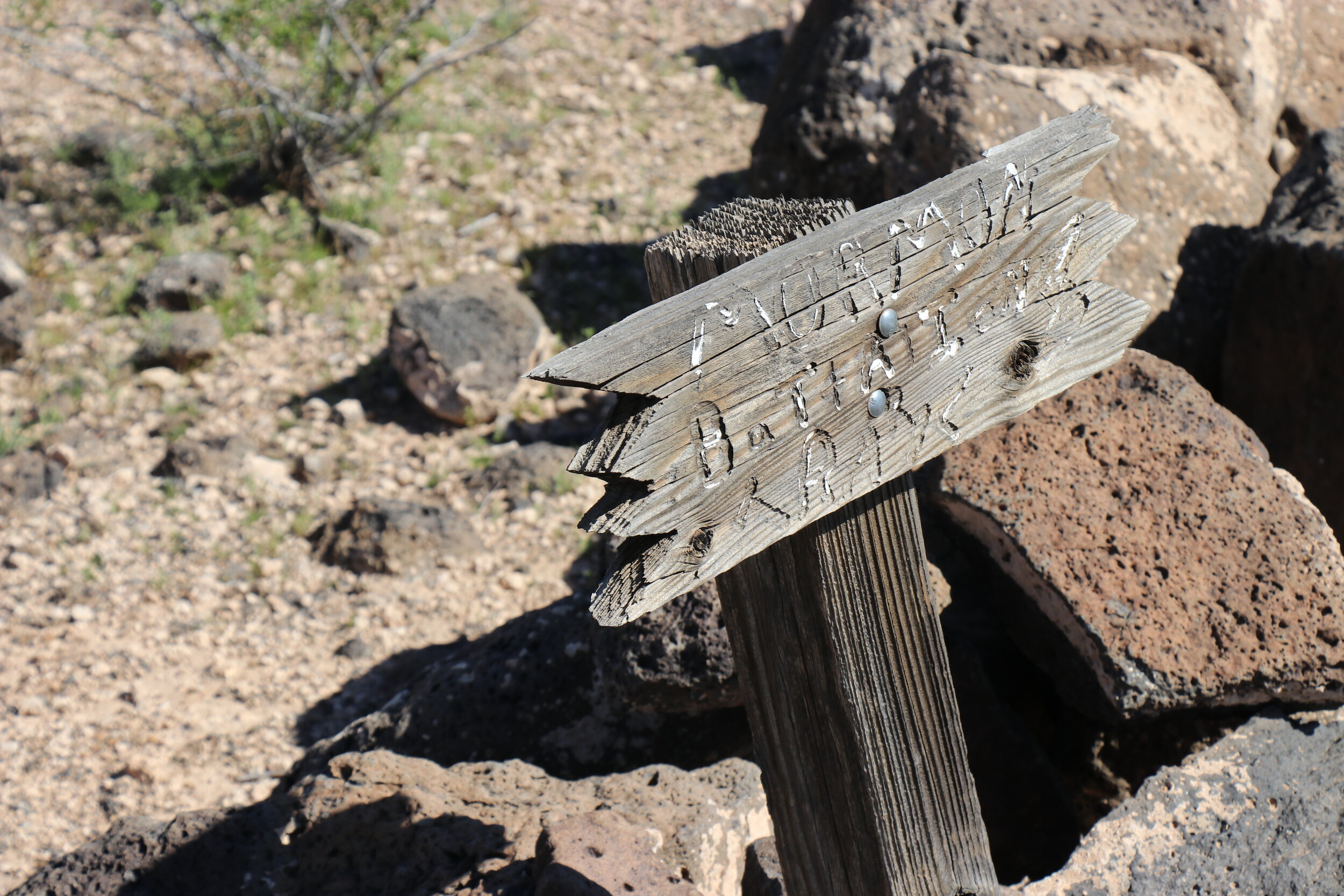Maricopa County
Oatman Massacre
Attacked in 1851, much of the Oatman Family was killed, in a story that later intrigued the nation.
The Oatman Massacre is the location of the 1851 ambush of the Oatman Family as they traveled along the Gila Trail (also known as the Southern Emigrant Route). The attack occurred on a volcanic bluff, overlooking the Gila River in a remote stretch of desert about 26 miles west of Gila Bend. Six members of the Oatman Family were killed during the massacre and three survived, although one would later die in captivity.
The Oatmans, along with other families, set out from Independence, Missouri in August of 1850. The party was a sect of Mormonism known as Brewsterites. Their goal was to head for California in order to find religious freedom. The party traveled west, splitting several times due to disagreements. Royce Oatman took charge and led the group as far as Maricopa Wells, Arizona, which is about 60 miles east of the present-day massacre site. When they reached this oasis in the desert, the wagon train was exhausted from the journey. The party opted to stay put knowing that the upcoming miles would be particularly barren and dangerous. The desert west of Gila Bend contained few water stops, extreme heat, and was home to numerous groups of hostile Native Americans. However, Royce was determined to press on to their destination at the mouth of the Colorado River.
The massacre site sits on the Sentinel Plain, a rugged stretch of desert west of Gila Bend.
The Oatmans -- which consisted of Royce, his 8 ½ month pregnant wife Mary Ann, and seven children -- continued on alone as they pushed west. Four days after leaving Maricopa Wells, sometime in February or March of 1851, they arrived at a small flat area along the Gila River. The edge of the river valley featured rugged volcanic bluffs of the Sentinel Plain. The Oatman’s pushed west and slowly climbed the rocky hill, pushing their animals to the limit. By this point, they were already beyond exhausted. The family had to unload the wagon and hand carry supplies up the hill to save weight.
By the end of the day, they finally reached the top of the hill and began to reload their supplies. Mary-Ann prepared a simple bean soup and bread dinner for the family. Their goal was to push on through the night, avoiding the more intense heat of the day. At this point, the family was approached by a group of Native Americans, who initially appeared friendly. They asked Royce for tobacco and he obliged. They then asked for cornmeal. Royce told them the family was short on supplies but reluctantly gave them some bread. The Natives continued to ask for supplies and grew impatient with Royce’s stinginess. They soon turned violent and clubbed much of the family to death. Lorenzo, age 15, was beaten and left for dead near the edge of the bluff. The Native’s took Olive, age 14, and Mary Ann, age 7 as captives. The other six Oatmans were left dead where they fell.
Somehow, against all odds, Lorenzo survived the attack and in the following days, managed to get to help and heal. He met up with other members of a wagon train and returned to the massacre site three days later. Lorenzo buried his family underneath a single large rock pile since the ground at the massacre site was too tough. He was determined to get his sisters back. Originally thought to be Apache, the family had actually been attacked by Western Yavapais, who were over 50 miles south of their traditional tribal land. Following the massacre, the Oatman girls moved with the tribe back to their village to the north, which was located in the Harquahala Mountains south of Aguila. In captivity with the Yavapais, the girls were treated rough -- often being forced to gather food and haul water or firewood. During a trading expedition with the Mohave Tribe, the Mohave Chief’s daughter saw the rough treatment of the girls and insisted on trading for them. The Yavapai initially rejected the offer but after returning some time later, the Oatman girls were eventually traded to the Mohaves in exchange for two horses, vegetable, blankets, and beads.
Numerous scratch marks from wooden wagon wheels remain on the rocks along the Gila Trail today.
The Oatman’s were re-buried below the massacre site. Access to it is questionable, as it sits on a private farm.
With the Mohaves, the girls were quickly welcomed into one of the tribal leaders' family. The tribe lived in the area around present day Needles, California. Mary Ann and Olive were given plots of land to farm and both girls received traditional chin and arm tattoos, marking them as members of the Mohaves. Sometime in 1855 or 1856, Mary Ann died from starvation while living among the tribe.
Within about a year, a messenger from Fort Yuma arrived at the Mohaves village. By this point, they had heard rumors of a white girl living amidst the tribe and requested her return, or to know why she didn’t wish to return. The Mohaves initially denied the claims but after multiple attempts, a trade offering, and a threat of violence from white settlers, they eventually conceded. After talking with Olive, the Mohaves sent her on a twenty day journey to Fort Yuma. She was escorted by the Chief’s daughter -- the one who had convinced the tribe to trade for the Oatman girls in the first places.
Once at Fort Yuma, Olive was welcomed by a cheering crowd. She learned that her brother Lorenzo had survived the massacre and had been looking for her and Mary Ann. They finally rejoined and the story of the Oatmans -- from massacre, to captivity, and eventual release -- quickly made headlines. The story intrigued people all over the country and attracted the attention of Royal B. Stratton. Stratton was a pastor and in 1857, co-authored a book retelling the account of the Oatmans, which was rumored to be sensationalized. Lorenzo and Olive traveled the country on a book tour, telling their stories to eager ears.
Today, a simple rock pile and sign mark the massacre site, which remains remote & desolate. Numerous crosses remain scattered around on the edge of the bluff. While the sign says February 18th, the unclear record keeping of the era suggests that this could have occurred sometime in February or March of 1851. The Oatman Family was eventually moved from the massacre site and laid to rest in the river valley below, marked by a grave site which sits near a cluster of trees just to the east. Access to the gravesite is questionable as many of the agricultural roads leading to it are under new ownership.
Walking down the old wagon road, you can actually still see numerous places where the wooden wheels of those traveling the Gila Trail (including the Oatmans) have marked up the surface. You have to look close, but numerous signs of earlier travelers remain. Numerous initials remain carved into the volcanic rocks around the massacre site. The modern town of Oatman is named for Olive, even though it sits over 150 miles away from the massacre site.
While the massacre is definitely the most notable event here, it is not the only significant piece of history. This has been a high traffic area for hundreds of years. First used by early Native Americans following the Gila River, it was later used by pioneers and prospectors traveling west to California. By the mid-1840s it became known as the Gila Trail, known today as the Southern Emigrant Trail. The route was used by groups like the Mormon Battalion (1847), the Oatmans (1851), and by the San Antonio and San Diego Mail Line (1857). In 1858 John Butterfield used a similar route in his establishment of the Butterfield Overland Mail service.
Butterfield’s Route sits just 50 feet south of the trail the Oatman’s traveled on -- and it was better constructed. The road was wider, had slight curves to ease the grade, and while it followed the Gila Trail in most places, it was improved in many areas to allow for the more efficient delivery of mail and passengers. The Butterfield Route was only used until the onset of the Civil War in early 1861, but his route and amenities would continue supporting migrants along the trail until the creation of the railroad in 1880.
Near the bluff east of the massacre site sits Fourr Cemetery, named for William Fourr. Fourr was a Butterfield employee at the Oatman Flat Station, located just to the north, and he even created his own station and unsuccessful toll road in the following years. The cemetery remains well preserved today thanks to an Eagle Scout project and the scars of the former wagon lines can still be seen on the edges of the volcanic bluff. From the Oatman Massacre site, you can walk about 50 feet to the southeast and see the Butterfield Line remnants. You’ll notice the wider footprint of the path (to allow for wagons to be longer and move faster) and the curves and gentler grade it has. The stagecoach line can be followed southwest from the massacre, where some parts remain well preserved.
The Butterfield Trail continues west from the massacre site. The flat grey area would have been the trail, with larger rocks moved to the side.
The Oatman Massacre is truly a fascinating story about early pioneer life in Arizona. The rich history of the area and the numerous groups of people that traveled through only add to the intrigue. While the massacre site doesn’t have a ton to physically look at, with time and the right eye, you can discover numerous interesting things like petroglyphs, graves, and wagon wheel marks. The easiest way to visit the site is via Agua Caliente Road from Sentinel & I-8. The nine mile drive remains easy except for the last mile and a half which traverses over rocky volcanic landscape. Visit our trail page for more specific directions and be sure to leave it like you found it.
Sources:
Talking with local historian Gerald T. Ahern at the Oatman Massacre in February of 2020.
Mifflin, Margot. The Blue Tattoo: The Life of Olive Oatman. Lincoln, Neb.: U of Nebraska, 2011. Google Books. Apr. 2009. Web. 2 Oct. 2020. <https://www.google.com/books/edition/The_Blue_Tattoo/c_w0DxpwKbgC?hl=en&gbpv=0>.
Bell, Bob Boze. "The Oatman Massacre." True West Magazine. 15 Feb. 2018. Web. 2 Oct. 2020. <https://truewestmagazine.com/oatman-massacre/>.
"Olive Oatman." Wikipedia. Wikimedia Foundation, 03 Dec. 2020. Web. 2 Oct. 2020. <https://en.wikipedia.org/wiki/Olive_Oatman>.
Stratton, Royal B. Captivity of the Oatman Girls: Being an Interesting Narrative of Life Among the Apache and Mohave Indians. Cambridge: Harvard U, 1859. Google Books. 17 Aug. 2006. Web. 2 Oct. 2020. <https://www.google.com/books/edition/Captivity_of_the_Oatman_Girls/CFoYoDvI3x8C?hl=en&gbpv=0>.
"Church of Christ (Brewsterite)." Wikipedia. Wikimedia Foundation, 16 Dec. 2019. Web. 2 Oct. 2020. <https://en.wikipedia.org/wiki/Church_of_Christ_(Brewsterite)>.












